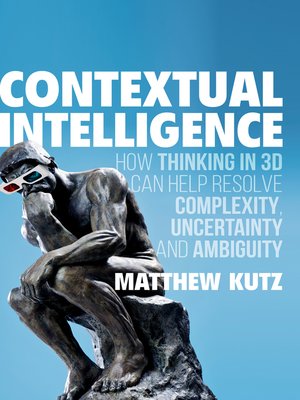Contextual Intelligence
ebook ∣ How Thinking in 3D Can Help Resolve Complexity, Uncertainty and Ambiguity · Business and Management
By Matthew Kutz

Sign up to save your library
With an OverDrive account, you can save your favorite libraries for at-a-glance information about availability. Find out more about OverDrive accounts.
Find this title in Libby, the library reading app by OverDrive.



Search for a digital library with this title
Title found at these libraries:
| Library Name | Distance |
|---|---|
| Loading... |
This book offers a structured framework for critical thinking and decision making that shows how to use hindsight, insight, and foresight to navigate through complexity.
Every organization and every person faces rapid change and complexity. Contextual intelligence – understanding fully the context in which one is operating – teaches the reader how to navigate that complexity and respond appropriately in the face of change (expected and unexpected).
The Three-Dimensional (3D) Thinking™ framework helps structure critical thinking by showing how to appropriately bring past experience, present intuition, and future ambiguity– in other words: hindsight, insight, and foresight – to bear on any given problem.
Kutz offers a way to rationally organize difficult concepts such as complexity, tacit knowledge, and synchronicity into usable and understandable language, but more importantly teaches the reader how to apply these concepts in a very practical and meaningful way with measurable and tangible outcomes.
The book also describes in detail 12 behaviors associated with contextual intelligence. Four behaviors are associated with hindsight, four behaviors are associated with insight, and four behaviors are associated with foresight. The book takes the reader through the 12 behaviors and how they relate to 3D Thinking.
Cases and anecdotes are used generously to provide examples. Chapters are followed by critical thinking questions and questions related to the cases in the chapters. Furthermore, questions and practical tools are introduced that help the reader assess and determine their level of contextual intelligence.






